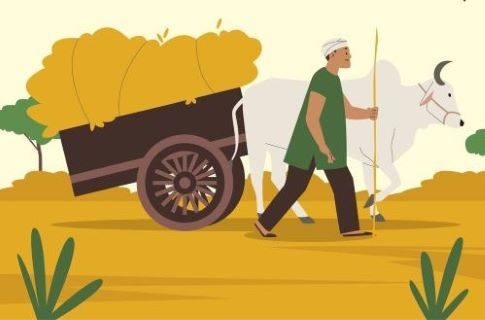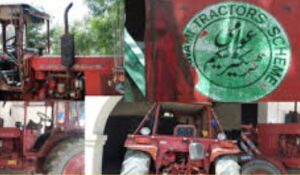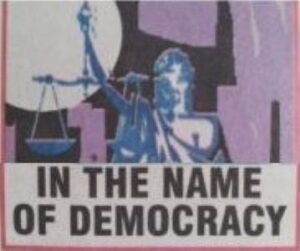Forgotten peasantry and lands of lords

By Shahid Rizvi
A barefooted man in rags, swimming and dabbling on the brick flooring, his knees palm, and nose badly bruised and bleeding— it is not a picture from a king’s court in medieval times. The scene is from an ‘autaq’ of a landlord and Sindh. The downtrodden man is a ‘hari’ (peasant), charged with theft of a horse, the guilt is not proved but he is nevertheless being punished for it.
The peasants in Sindh are such a lot —-virtually slaves. Quite a few cases were reported in newspapers recently when poor patients and their families got freedom from the private jails of landlords. These peasants were indebted to the landlord and imprisoned for many years.
Sindh with a rural population of an estimated 16.6 million is still in the grip of feudal lords ruling like mini-kings. With next-to-nothing industries, the interior of the province is primarily agrarian. The bulk of the farms which are owner-cultivated are small uneconomic holdings, while tractor-efficient big farms are under the domain of feudal families.
The highest number of rural populations comprises landless peasants who work on lord’s lands as tenants or seasonal workers. Those owning small farms also have to work on the big landlord’s lands to make both ends meet. This economic dependence of the hari and the rural society as a whole, on the landlord class, forms the basis of the authority of the feudal lord.
With decadence in the name of traditions being handed down to successive generations, the authority of the feudal lord has become absolute.
The supreme power of feudal played a vital role in the wheeling and dealing process of king-making and explained his political clout. Democracy although painfully being established with repeated breaks, is still confined to the upper crest comprising mostly of the feudal lords and has not yet filtered down to the bottom strata of society.
As a policy, rulers always keep the poorer sections of the society in unseen fetters. The undermining of the economic status and stability of the people at large is one of the basic elements of this policy. This policy works wonders. Sindhi hari is illiterate, remains penniless, in tattered clothes, without proper housing and potable water facilities, and infatuated with conservatism and weird superstitious.
Fatalist by belief, he sees his plight as eternal and seeks solace in the idea that it is God’s ordained. A wadera will always remain wadera and he will always be subjected to him —- an edict of mother nature. He has to obey the wadera in all respects and unconditionally submit to his whims and wishes. This has denied the ‘hari’ with needed creativity in the vitally important economic and social spheres. The general attitude of a ‘hari’ towards life is one of the lethargies.
The main curse, of course, is ‘Batai’ an obligation of tenancy. the land is titled by the farmer and when the crop is ready, it is shared between landlord and farmer, the farmer taking away up to two- third of the total crop. The seeds, fertilizers, and cattle to pull the plough are all provided by the farmer and not shared by the landlord. Under the law — Sindh Tenancy Act 1951—- the crop and inputs are all to be shared fifty-fifty by the landlord and the farmer. The two-third exploit adds to the landlord’s social status. With the power so gained, the landlord keeps the law in abeyance and the vicious cycle continues. In many cases the share of the farmer is less than one-third — a bare minimum subsistence for the whole year. Coupled with many other illegal and unlawful recoveries and services, the life of a farmer is made even more miserable.
A big problem is ejectment from the landlord throws the farmer out of the field just when it is harvesting time. This ejectment hovers over the farmer’s nightmarish life. Forcible ejectment of a tenant is an effective tool of power in the hands of the landlord.
In certain cases, tenants working on the same land for generations are considered uneconomical, and thus undesirable, by the landlord and are unceremoniously removed from the farm. Sindh Tenancy Act terms a tenant cultivating the same piece of land for three years as a “hereditary tenant” and disproves his ejectment. The law provides that no ejectment of the ‘haris’ should be made without orders from the Tribunal.
The law, however, remains something to be bent at the whims of the landlord.
The Sindh Tenancy Act further provides that if a hereditary peasant dies, his heir should be given possession of the land to cultivate, and only on his refusal to do so could the land be given to others. It is a known fact that this is not practiced.
The act has strictly prohibited “Begar” – forced labor without compensation. It is a widespread and old practice by landlords who order one member from each family to join the cultivation of a piece of land measuring one to five hundred acres belonging to the landlord, without any payment in cash or kind. This begar is a coercive “gesture of goodwill” to the Zamindar and the order is mandatory. The landlord do not tolerate any slackness in labor on the barred piece of land.
Another form of ‘Begar’ is called ‘char’ – forced labor for cleaning and remodeling hundreds of miles of water courses. The peasant families have to work day and night for dredging and cleaning. The landlord receives payments in millions for the work from the government. It is a tedious job. Though under the law this type of ‘begar’ is also prohibited, it is still widely in practice.
The ‘haris’ of Sindh have waged an all-out struggle against the tyranny of feudalism. Their oldest war was led by the Sufi Shah Inayat whose mazar in a Jhok, Thatta serves as a beacon of light for the ‘haris’ Sufi Shah Inayat raised the slogan “land to the tiller” and distributed his own lands to the farmers.
The struggle of the patients was supported by the famous ‘Hari report’ prepared by Masud Khadar Posh in the 1940s. This report gave a very detailed analysis of feudalism and the deplorable conditions of the peasantry. Then there came on the scene Comrade Haider Bux Jatoi, the luminous star of Sindh’s hari movement.’ The Sindh Hari Committee launched many a struggle and mobilized haris in each village of Sindh. It led to the ‘Batai’ movement which demanded half a share of hari in the crop and the provision of half inputs by the landlord.
Then came to the Allottee Tehrik against unlawful allotments of land and absentee landlordism. After this movement came the massive “Stop Beggar” movement. These movements left a very strong impact on the course of history.
Different land reforms and legislations could not deliver the goods because each and our large number of exemption which made the reforms ineffective and infructuous.
The main problem of land reform i.e. abolishing feudalism and true spirit and distribution of land to the tillers was not touched by any reform. Some Acts restricted the ownership of land to 50 acres but landlord manipulated them to keep their land to their families.
The problem can be solved if the proper distribution of land is made on the basis of “land to the tiller” absentee landlordism is prohibited, the land is delimited into tractor-efficient farms, the land record is computerized and laws are vigilantly enforced. It is also necessary to mobilize peasants to be able to protect their rights and curtails the powers and influence of the landlords.








